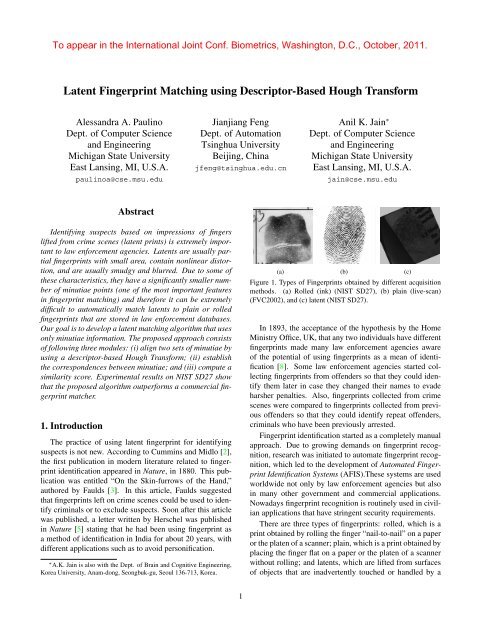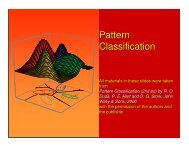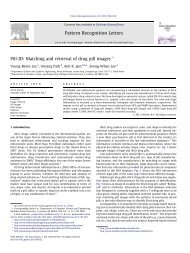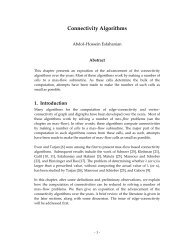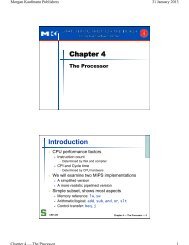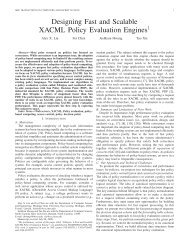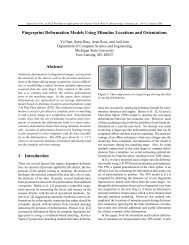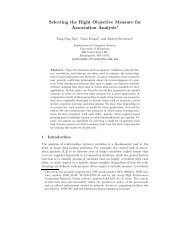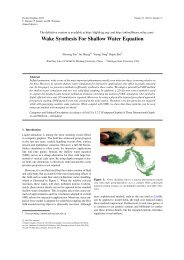Latent Fingerprint Matching using Descriptor-Based Hough Transform
Latent Fingerprint Matching using Descriptor-Based Hough Transform
Latent Fingerprint Matching using Descriptor-Based Hough Transform
You also want an ePaper? Increase the reach of your titles
YUMPU automatically turns print PDFs into web optimized ePapers that Google loves.
<strong>Latent</strong> <strong>Fingerprint</strong> <strong>Matching</strong> <strong>using</strong> <strong>Descriptor</strong>-<strong>Based</strong> <strong>Hough</strong> <strong>Transform</strong><br />
Alessandra A. Paulino<br />
Dept. of Computer Science<br />
and Engineering<br />
Michigan State University<br />
East Lansing, MI, U.S.A.<br />
paulinoa@cse.msu.edu<br />
Abstract<br />
Identifying suspects based on impressions of fingers<br />
lifted from crime scenes (latent prints) is extremely important<br />
to law enforcement agencies. <strong>Latent</strong>s are usually partial<br />
fingerprints with small area, contain nonlinear distortion,<br />
and are usually smudgy and blurred. Due to some of<br />
these characteristics, they have a significantly smaller number<br />
of minutiae points (one of the most important features<br />
in fingerprint matching) and therefore it can be extremely<br />
difficult to automatically match latents to plain or rolled<br />
fingerprints that are stored in law enforcement databases.<br />
Our goal is to develop a latent matching algorithm that uses<br />
only minutiae information. The proposed approach consists<br />
of following three modules: (i) align two sets of minutiae by<br />
<strong>using</strong> a descriptor-based <strong>Hough</strong> <strong>Transform</strong>; (ii) establish<br />
the correspondences between minutiae; and (iii) compute a<br />
similarity score. Experimental results on NIST SD27 show<br />
that the proposed algorithm outperforms a commercial fingerprint<br />
matcher.<br />
1. Introduction<br />
The practice of <strong>using</strong> latent fingerprint for identifying<br />
suspects is not new. According to Cummins and Midlo [2],<br />
the first publication in modern literature related to fingerprint<br />
identification appeared in Nature, in 1880. This publication<br />
was entitled “On the Skin-furrows of the Hand,”<br />
authored by Faulds [3]. In this article, Faulds suggested<br />
that fingerprints left on crime scenes could be used to identify<br />
criminals or to exclude suspects. Soon after this article<br />
was published, a letter written by Herschel was published<br />
in Nature [5] stating that he had been <strong>using</strong> fingerprint as<br />
a method of identification in India for about 20 years, with<br />
different applications such as to avoid personification.<br />
∗ A.K. Jain is also with the Dept. of Brain and Cognitive Engineering,<br />
Korea University, Anam-dong, Seongbuk-gu, Seoul 136-713, Korea.<br />
Jianjiang Feng<br />
Dept. of Automation<br />
Tsinghua University<br />
Beijing, China<br />
jfeng@tsinghua.edu.cn<br />
1<br />
Anil K. Jain ∗<br />
Dept. of Computer Science<br />
and Engineering<br />
Michigan State University<br />
East Lansing, MI, U.S.A.<br />
jain@cse.msu.edu<br />
(a) (b) (c)<br />
Figure 1. Types of <strong>Fingerprint</strong>s obtained by different acquisition<br />
methods. (a) Rolled (ink) (NIST SD27), (b) plain (live-scan)<br />
(FVC2002), and (c) latent (NIST SD27).<br />
In 1893, the acceptance of the hypothesis by the Home<br />
Ministry Office, UK, that any two individuals have different<br />
fingerprints made many law enforcement agencies aware<br />
of the potential of <strong>using</strong> fingerprints as a mean of identification<br />
[8]. Some law enforcement agencies started collecting<br />
fingerprints from offenders so that they could identify<br />
them later in case they changed their names to evade<br />
harsher penalties. Also, fingerprints collected from crime<br />
scenes were compared to fingerprints collected from previous<br />
offenders so that they could identify repeat offenders,<br />
criminals who have been previously arrested.<br />
<strong>Fingerprint</strong> identification started as a completely manual<br />
approach. Due to growing demands on fingerprint recognition,<br />
research was initiated to automate fingerprint recognition,<br />
which led to the development of Automated <strong>Fingerprint</strong><br />
Identification Systems (AFIS).These systems are used<br />
worldwide not only by law enforcement agencies but also<br />
in many other government and commercial applications.<br />
Nowadays fingerprint recognition is routinely used in civilian<br />
applications that have stringent security requirements.<br />
There are three types of fingerprints: rolled, which is a<br />
print obtained by rolling the finger “nail-to-nail” on a paper<br />
or the platen of a scanner; plain, which is a print obtained by<br />
placing the finger flat on a paper or the platen of a scanner<br />
without rolling; and latents, which are lifted from surfaces<br />
of objects that are inadvertently touched or handled by a
person typically at crime scenes (see Fig. 1). Lifting of latents<br />
may involve a complicated process, and it can range<br />
from simply photographing the print to more complex dusting<br />
or chemical processing.<br />
Rolled prints contain the largest amount of information<br />
about the fingerprint since they contain information<br />
from nail-to-nail; latents usually contain the least amount<br />
of information for matching or identification. Compared to<br />
rolled or plain fingerprints, latents are smudgy and blurred,<br />
capture only a small finger area, and have large nonlinear<br />
distortion due to pressure variations. Due to their poor quality<br />
and small area, latents have a significantly smaller number<br />
of minutiae compared to rolled or plain prints (the average<br />
number of minutiae in NIST Special Database 27 (NIST<br />
SD27) [12] images is 21 for latents versus 106 for the corresponding<br />
rolled prints). Those characteristics make the<br />
latent fingerprint matching problem very challenging.<br />
Manual latent fingerprint identification is performed following<br />
a procedure referred to as ACE-V (analysis, comparison,<br />
evaluation and verification) and it requires a large<br />
amount of human intervention. Because this procedure is<br />
quite tedious and time consuming for latent examiners, latents<br />
are usually matched against full prints of a small number<br />
of suspects identified by other means. With the invention<br />
of AFIS, fingerprint examiners identify latents <strong>using</strong><br />
a semi-automatic procedure that consists of following<br />
stages: (i) manually mark the features (minutiae and singular<br />
points) in the latent, (ii) launch an AFIS search, and (iii)<br />
visually verify each of the candidate fingerprints returned<br />
by AFIS. The accuracy and speed of this procedure is still<br />
not satisfactory.<br />
Recent studies on latent fingerprints can be classified<br />
into two categories according to their objective: higher<br />
matching accuracy [4, 6, 7] or higher degree of automation<br />
[15, 13]. Improved latent matching accuracy has been<br />
reported by <strong>using</strong> extended features which are manually<br />
marked for latents [6, 7]. However, marking extended features<br />
(orientation field, ridge skeleton, etc.) in poor quality<br />
latents is very time-consuming and might be only feasible<br />
in rare cases.<br />
NIST has been conducting a multi-phase project on Evaluation<br />
of <strong>Latent</strong> <strong>Fingerprint</strong> Technologies (ELFT) to evaluate<br />
automatic latent feature extraction and matching techniques<br />
[10]. In Phase I, the most accurate system showed<br />
a rank-1 accuracy of 80% (100 latents against 10, 000<br />
rolled prints). In Phase II, the rank-1 accuracy of the most<br />
accurate system was 97.2% (835 latents against 100, 000<br />
rolled prints). These accuracies cannot be directly compared<br />
since the Phase I and Phase II evaluations used different<br />
databases. Also, the quality of latents used in Phase<br />
II is better compared to Phase I. Fig. 2 shows three latents of<br />
different quality in NIST SD27. The impressive matching<br />
accuracy reported in ELFT does not mean that the current<br />
(a) (b) (c)<br />
Figure 2. <strong>Latent</strong> fingerprints of three different quality levels in<br />
NIST SD27. (a) Good, (b) Bad, and (c) Ugly.<br />
practice of manually marking minutiae in latents should be<br />
changed.<br />
The goal of this work is to develop a latent fingerprint<br />
matching algorithm that is solely based on minutiae. Since<br />
manually marking minutiae in latents is a common practice<br />
in the latent fingerprint community, the proposed matcher<br />
can be directly used in operational settings.<br />
The rest of the paper is organized as follows: in Section<br />
2, all steps of our proposed method are described; in Section<br />
3, our experimental results are presented and discussed; in<br />
Section 4, we present our conclusions and future work.<br />
2. <strong>Latent</strong> <strong>Matching</strong> Approach<br />
There are three main steps in fingerprint matching: alignment<br />
(or registration) of the fingerprints, pairing of the<br />
minutiae, and score computation. In our approach, we use<br />
a <strong>Descriptor</strong>-based <strong>Hough</strong> <strong>Transform</strong> to align two fingerprints.<br />
Given two sets of aligned minutiae, two minutiae are<br />
considered as a matched pair if their Euclidean distance and<br />
direction difference are less than pre-specified thresholds.<br />
Finally, a score is computed based on a variety of factors<br />
such as the number of matched minutiae and the similarity<br />
between the descriptors of the matched minutiae pairs. Figure<br />
3 1 shows an overview of the proposed approach. It is<br />
important to emphasize that while latents are manually encoded<br />
(namely marking minutiae), minutiae in rolled prints<br />
are automatically extracted.<br />
2.1. Local Minutia <strong>Descriptor</strong><br />
Minutia Cylinder-Code (MCC) is a minutiae representation<br />
based on 3D data structures [1]. In the MCC representation,<br />
a local structure is associated to each minutia. This<br />
local structure is represented as a cylinder, which contains<br />
information about the relationship between a minutia and<br />
its neighboring minutiae. The base of the cylinder is related<br />
to the spatial relationship, and its height is related to the directional<br />
relationship. Each cell in the cylinder accumulates<br />
contributions from each minutia in the neighborhood. The<br />
resulting cylinder can be viewed as a vector, and therefore<br />
the similarity between two minutia descriptors can be easily<br />
1 Local minutia descriptors shown in Figure 3 is from [1].
computed as a vector correlation measure. A more detailed<br />
description of the cylinder generation and of the similarity<br />
between two cylinders can be found in [1]. This representation<br />
presents some advantages, such as: invariant to translation<br />
and rotation; robust against small skin distortion and<br />
missing or spurious minutiae; and of fixed length.<br />
2.2. <strong>Fingerprint</strong> Alignment<br />
<strong>Fingerprint</strong> alignment or registration consists of estimating<br />
the parameters (rotation, translation and scale) that align<br />
two fingerprints. There are a number of features that may<br />
be used to estimate alignment parameters between two fingerprints,<br />
including orientation field, ridges and minutiae.<br />
There are also a number of ways of aligning two fingerprints:<br />
Generalized <strong>Hough</strong> <strong>Transform</strong>, local descriptors, energy<br />
minimization, etc.<br />
In the latent fingerprint case, singularities are not always<br />
present, making it difficult to base the alignment of<br />
the fingerprint on singular points alone. To obtain manually<br />
marked orientation field is expensive, and to automatically<br />
extract orientation field from a latent image is a very<br />
challenging problem. Since manually marking minutiae is a<br />
common practice for latent matching, our approach to align<br />
two fingerprints is based on minutiae.<br />
Ratha et al. introduced an alignment method for minutiae<br />
matching that estimates rotation, scale, and translation<br />
parameters <strong>using</strong> a Generalized <strong>Hough</strong> <strong>Transform</strong> [14].<br />
Figure 3. Overview of the proposed approach.<br />
Given two sets of points (minutiae), a matching score is<br />
computed for each transformation in the discretized set of<br />
all allowed transformations. For each pair of minutiae, one<br />
minutia from each set, and for given scale and rotation parameters,<br />
unique translation parameters can be computed.<br />
Each parameter receives “a vote” proportional to the matching<br />
score for the corresponding transformation. The transformation<br />
that gives the maximum score is considered the<br />
best one. In our approach, the alignment is conducted in<br />
a very similar way, but the evidence for each parameter is<br />
accumulated based on the similarity between the local descriptors<br />
of the two involved minutiae, with the similarity<br />
and descriptor being the ones described in Section 2.1.<br />
Given two sets of minutiae, one from the latent and the<br />
other from the rolled print being compared, translation and<br />
rotation parameters can be obtained for each possible minutiae<br />
pair (one minutia from each set). Let {(
can be obtained for each pair based on the rotation difference<br />
between the minutiae in the pair. The translation<br />
and rotation parameters need to be quantized to the closest<br />
bins. After the quantization, evidence is accumulated in<br />
the correspondent bin based on the similarity between the<br />
local minutiae descriptors. The assumption here is that true<br />
mated minutiae pairs will vote for very similar sets of alignment<br />
parameters, while non-mated minutiae pairs will vote<br />
randomly throughout the parameter space. As a result, the<br />
set of parameters that presents the highest evidence is considered<br />
the best one. For robustness, more than one set of<br />
alignment parameters with high evidence are considered.<br />
In order to make the alignment computationally efficient<br />
and also more accurate, we use a two-stage approach for<br />
the <strong>Descriptor</strong>-based <strong>Hough</strong> <strong>Transform</strong>. We first perform<br />
the voting in a relatively coarse parameter space. <strong>Based</strong> on<br />
the peaks in the <strong>Hough</strong> space, we repeat the voting inside a<br />
neighborhood around the peaks, but with a more refined set<br />
of parameter range. We also keep track of the points that<br />
contribute to the peaks and then compute a rigid transformation<br />
matrix from those points.<br />
2.3. Minutiae Pairing<br />
After aligning two sets of minutiae, we need to find the<br />
minutiae correspondences between the two sets, i.e. minutiae<br />
need to be paired. The pairing of minutiae consists of<br />
finding minutiae that are sufficiently close in terms of location<br />
and direction. Let
Percentage of Correctly Aligned <strong>Latent</strong>s<br />
100<br />
95<br />
90<br />
85<br />
80<br />
75<br />
70<br />
65<br />
60<br />
Alignment Accuracy<br />
55<br />
Verifinger<br />
Most similar minutia pair (MCC)<br />
<strong>Descriptor</strong>−based <strong>Hough</strong> <strong>Transform</strong> Alignment<br />
50<br />
10 12 14 16 18 20 22 24 26<br />
Average error in alignment (pixels)<br />
28 30<br />
Figure 4. Alignment Accuracy: percentage of correctly aligned<br />
latents vs. alignment error.<br />
[1], with the number of cells along the cylinder diameter<br />
as 8 (
Identification Rate (%)<br />
Identification Rate (%)<br />
100<br />
90<br />
80<br />
70<br />
60<br />
50<br />
40<br />
30<br />
Verifinger<br />
Proposed Matcher<br />
20<br />
0 5 10 15 20 25 30<br />
100<br />
90<br />
80<br />
70<br />
60<br />
50<br />
40<br />
Rank<br />
(b) Good Quality<br />
30<br />
Verifinger<br />
Proposed Matcher<br />
20<br />
0 5 10 15 20 25 30<br />
Rank<br />
(e) Large Quality<br />
Identification Rate (%)<br />
Identification Rate (%)<br />
Identification Rate (%)<br />
100<br />
90<br />
80<br />
70<br />
60<br />
50<br />
40<br />
30<br />
Verifinger<br />
Proposed Matcher<br />
20<br />
0 5 10 15 20 25 30<br />
100<br />
90<br />
80<br />
70<br />
60<br />
50<br />
40<br />
Rank<br />
(a) All Qualities<br />
30<br />
Verifinger<br />
Proposed Matcher<br />
20<br />
0 5 10 15 20 25 30<br />
100<br />
90<br />
80<br />
70<br />
60<br />
50<br />
40<br />
Rank<br />
(c) Bad Quality<br />
30<br />
Verifinger<br />
Proposed Matcher<br />
20<br />
0 5 10 15 20 25 30<br />
Rank<br />
(f) Medium Quality<br />
Identification Rate (%)<br />
Identification Rate (%)<br />
100<br />
90<br />
80<br />
70<br />
60<br />
50<br />
40<br />
30<br />
Verifinger<br />
Proposed Matcher<br />
20<br />
0 5 10 15 20 25 30<br />
100<br />
90<br />
80<br />
70<br />
60<br />
50<br />
40<br />
Rank<br />
(d) Ugly Quality<br />
30<br />
Verifinger<br />
Proposed Matcher<br />
20<br />
0 5 10 15 20 25 30<br />
Rank<br />
(g) Small Quality<br />
Figure 6. Overall matching performance (in terms of ROC curves) for latents with different subjective and objective qualities. Manually<br />
marked minutiae in latents are used as input for both the matchers (proposed and VeriFinger).<br />
of the alignment errors — there are not enough matching<br />
minutiae pairs in the overlapping area between the latent<br />
and its mated rolled print.<br />
4. Conclusions and Future Work<br />
We have presented a fingerprint matching algorithm designed<br />
for matching latents to rolled/plain fingerprints. Our<br />
algorithm outperforms the commercial matcher VeriFinger<br />
over all qualities of latents in NIST SD27. The improvement<br />
in the rank-1 accuracy of the proposed algorithm over<br />
VeriFinger varies from 2.3% for latents with relatively large<br />
number of minutiae to as high as 22% for latents with<br />
the subjective quality “ugly”. These results show that our<br />
matcher is more suitable for latent fingerprints.<br />
The proposed alignment method performs very well even<br />
on latents that contain small number of minutiae. In our algorithm<br />
we take the maximum score from several hypothesized<br />
alignments based on different alignment parameters.<br />
Sometimes, the maximum score does not correspond to the<br />
correct alignment. We plan to improve the score computation<br />
by applying learning methods. Extended features manually<br />
marked by latent examiners have been shown to be<br />
beneficial for improving latent matching accuracy. We plan<br />
to incorporate extended features which are automatically<br />
extracted from the image into the current matcher to further<br />
improve the matching accuracy.
(a) (b)<br />
Figure 7. <strong>Latent</strong> prints correctly identified at rank-1.<br />
(a) (b)<br />
Figure 8. <strong>Latent</strong> prints that were not successfully matched. These two latents were matched to their true mates at ranks 1253 and 1057,<br />
respectively.<br />
Acknowledgment<br />
Anil Jain’s research was partially supported by WCU<br />
(World Class University) program funded by the Ministry<br />
of Education, Science and Technology through the National<br />
Research Foundation of Korea (R31-10008). Alessandra<br />
Paulino’s research was supported by the Fulbright Program<br />
(A15087649) and Brazilian Government through a CAPES<br />
Foundation/Ministry of Education grant (1667-07-6).<br />
References<br />
[1] R. Cappelli, M. Ferrara, and D. Maltoni. Minutia cylindercode:<br />
a new representation and matching technique for fingerprint<br />
recognition. IEEE Trans. PAMI, 32(12):2128–2141,<br />
December 2010. 2, 3, 5<br />
[2] H. Cummins and C. Midlo. Finger Prints, Palms and Soles:<br />
An Introduction to Dermatoglyphics. Dover Publications,<br />
Inc., 1961. 1<br />
[3] H. Faulds. On the skin-furrows of the hand. Nature,<br />
XXII:605, October 1880. 1<br />
[4] J. Feng, S. Yoon, and A. K. Jain. <strong>Latent</strong> fingerprint matching:<br />
Fusion of rolled and plain fingerprints. In International<br />
Conference on Biometrics (ICB), June 2009. 2<br />
[5] W. Herschel. Skin furrows of the hand. Nature, page 76,<br />
November 25th 1880. 1<br />
[6] A. K. Jain and J. Feng. <strong>Latent</strong> fingerprint matching. IEEE<br />
Trans. PAMI, 33(1):88–100, January 2011. 2, 4<br />
[7] A. K. Jain, J. Feng, A. Nagar, and K. Nandakumar. On<br />
matching latent fingerprints. In CVPR Workshops on Biometrics,<br />
pages 1–8, June 2008. 2<br />
[8] D. Maltoni, D. Maio, A. K. Jain, and S. Prabhakar. Handbook<br />
of <strong>Fingerprint</strong> Recognition. Springer-Verlag, 2nd edition,<br />
2009. 1<br />
[9] Neurotechnology Inc. Verifinger.<br />
http://www.neurotechnology.com/verifinger.html. 4<br />
[10] NIST. <strong>Latent</strong> fingerprint homepage.<br />
http://fingerprint.nist.gov/latent/index.html. 2<br />
[11] NIST Special Database 14. Mated fingerprint card pairs 2.<br />
http://www.nist.gov/srd/nistsd14.cfm. 4<br />
[12] NIST Special Database 27. <strong>Fingerprint</strong> minutiae<br />
from latent and matching tenprint images.<br />
http://www.nist.gov/srd/nistsd27.cfm. 2<br />
[13] A. A. Paulino, A. K. Jain, and J. Feng. <strong>Latent</strong> fingerprint<br />
matching: Fusion of manually marked and derived minutiae.<br />
In 23rd SIBGRAPI - Conference on Graphics, Patterns and<br />
Images, pages 63–70, August 2010. 2<br />
[14] N. K. Ratha, K. Karu, S. Chen, and A. K. Jain. A real-time<br />
matching system for large fingerprint databases. IEEE Trans.<br />
PAMI, 18(8):799–813, August 1996. 3<br />
[15] S. Yoon, J. Feng, and A. K. Jain. On latent fingerprint enhancement.<br />
In SPIE, volume 7667, April 2010. 2


